
The word, “data” – tables of numbers, incomprehensible graphs — for most of us would make a good sleep aid. For astronomers, though, “data” means a star-sized thing that outshines a galaxy, or a galaxy just being born, or a star that spins in milliseconds. Data for astronomers is a way to survive, a reason to live, a combination of money and ice cream. So when astronomers using the Kepler satellite to find earth-like planets around other suns told their fellow astronomers they were holding back the most promising data, those fellow astronomers reacted as though someone sequestered the ice cream.
In the olden days an astronomer with a telescope looked at his – and yes, it was likely to be “his” – stars and galaxies, took data on their brightness, size, color, distance, and published his wondrous discoveries and put the data in his closet. That proprietary attitude toward data changed a little toward the end of the 20th century, when new telescopes began to be paid for by NASA, the National Science Foundation, and the American taxpayer. Any astronomer who didn’t have his own telescope could use these telescopes and work on his data privately for a year, but then he had to turn it over to the public. So by rights, since Kepler is a NASA-funded satellite that launched over a year ago, the Kepler astronomers should make all 700 cases for possible planets public. Instead, they announced that they’ll release 300 stars that look like they have planets, and keep the 400 of the best stars with the most earthlike candidates for another eight months.
Since that announcement, both astronomers and science writers have been making a fuss in meetings, in print, and all over the internet. Arguments pro: the Kepler astronomers lost a season of observing to a launch delay; only half the 700 possibilities are likely to be real planets; the planets better be real because announcing imaginary planets is embarrassing; whoever finds the first earthlike planet at earthlike distances from its star will be famous. Arguments con: non-Kepler astronomers with Kepler data can find out if the planets are real as well as Kepler astronomers; 400 planets is a lot of data; whoever finds the first earthlike planet at earthlike distances from its star will be famous.
The cons have another argument: in recent years, astronomy has become even less proprietary, in large part because astronomers released to the public the largest-yet astronomical database. Astronomers with private funding finished a digital survey of the sky – “survey” meaning everything in a good fraction of the sky, “digital” meaning data in computers and sent over the internet. The survey astronomers released the data as they got it, not in a scholarly journal but on an elegant and public website. They first kept it for some months, partly to try to be famous but mostly to make sure the data weren’t buggy. This survey, the Sloan Digital Sky Survey, is just the first of several even bigger surveys coming on line, and some of those will be immediately public too. Public surveys are changing astronomy’s culture: not only can astronomers with telescopes do astronomy, so can astronomers in small colleges with no telescopes whatever, and in fact, so can the public (cf: Galaxy Zoo). So not only are the Kepler astronomers looking a little – understandably – selfish, they’re running against their community’s new culture.
In a way, the most interesting thing about this argument over public data is neither the cultural change nor the selfishness but the ultimate altruism. Kepler was first proposed over 30 years ago, was approved in 1999, and launched a year ago. The Sloan survey was proposed in 1987, began surveying in 1998, and accomplished most of its intentions by 2005. I can’t quite imagine taking decades to write a book and even if my name is on it, handing it out for free. I mean, who gives away money and ice cream?
Photo credit: European Southern Observatory
That’s a puzzling point that could potentially start an internet/ print argument all it’s own. I don’t see as handing out money and Ice cream for free, (although it would be nice, if insane, if people did that) but more handing out knowledge & discussion for free which happens every day. It appears to me that this can relate to the much shorter blog you, Ann, posted on the home page, Abstruse Goose: The Sum of All Knowledge, And these scientist are merely attempting to expand the island of knowledge in a sea of increasing ignorance.
You’re darn skippy right, Ms. Alex. Plus, smart, to see the relation between handing out knowledge for free and expanding the island into the sea.
Thanks for the links. After reading, I see nothing wrong with NASA’s plan to release the remaining information at a later date, as long as they live up to their promises.
I’d also be interested to hear how the SETI project is going? They once actively recruited the public to collect and analyze data on the Search for Extraterrestial Intelligence, but I haven’t heard much about it for at least a few years.
Did any SETI data inform the decision to search for planets around Cygnus?
I don’t see anything wrong with the NASA plan for releasing data either, and I also understand astronomers’ beefing about the extra time.
I haven’t kept up with the SETI project. The last I heard, they had a program called SETI@home which used peoples’ computers when the people weren’t. Or something like that. I think you should look into it and report back.